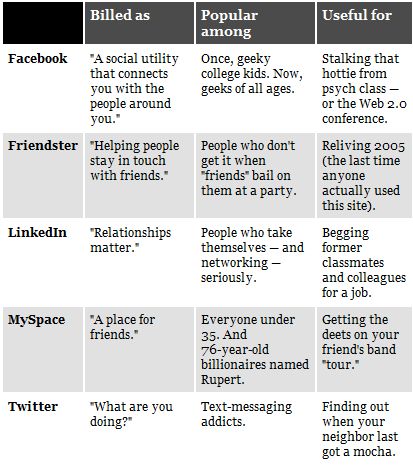von Roland Hachmann | Okt. 26, 2007 | Ad News, Blog, Digital Marketing, Marketing, Online Advertising, Social Media Marketing
von Roland Hachmann | Okt. 24, 2007 | Blog, Digital Culture, Social Media Marketing
Some interesting facts for my German readers: There is a new research published by TNS Infratest about about the users of web 2.0 offers. According to this research the senders or creators of content are still amongst the younger audience, while the recipients and content consumers are amongst all age groups:
Während etwa ein Drittel (33 Prozent) der Verfasser von Beiträgen [von Wikipedia] unter 20 Jahren sind, liegt der Anteil der Leser, die 30 Jahre und älter sind, bei 65 Prozent.
Also with blogs we need to differentiate:
Hier sind 41 Prozent der Personen mit einem eigenen Blog unter 20 Jahre alt. Die Blog-Leser hingegen sind deutlich älter, bereits 35 Prozent sind über 40 Jahre alt, nur 20 Prozent sind unter 20 Jahren. „Das heißt, Blogs werden zwar auch von Gleichaltrigen gelesen aber gleichzeitig scheinen sie auch für Personen interessant zu sein, die nicht direkt in der Altersgruppe des Blog-Besitzers zu finden sind. Dennoch sind aber auch Erwachsene unter den Blog-Schreibern: Immerhin ein Viertel aller Blog-Besitzer sind über 40 Jahren“
Notable is also the difference of topics chosen by men and women:
Am häufigsten werden Weblogs als persönliches Tagebuch genutzt (61 Prozent), aber auch konkrete Inhalte wie Reise & Urlaub (30 Prozent) und Wissen & Lernen (24 Prozent) werden von den Bloggern thematisiert. Frauen nutzen ihren Blog häufiger als persönliches Tagebuch (76 Prozent der Blog-Besitzerinnen). Männer behandeln eher konkrete Themen, wie Computer & Software und Nachrichten & Politik. Die Themengebiete Wissen & Lernen und Reise & Urlaub sind bei beiden Geschlechtern in gleichem Maße beliebt (jeweils ca. 30 Prozent der Blog-Besitzer).
Here you can find a PDF with some (very few) Charts.
von Roland Hachmann | Okt. 23, 2007 | Ad News, Blog, Digital Culture, Digital Marketing, Marketing, Marketing Trends, Social Media Marketing
Joe Jaffe, who just released his new book „join the conversation“ (and very successfully bumrushed the charts on amazon) also conducted a study (together with the Society for New Communications Research and TWI Surveys) on how marketers might shift their budgets to conversational findings.
Here is an excerpt from his blog (the whole study is here):
- Nearly 57% of respondents report that in 5 years time, what they spend on conversational marketing will be greater than that of traditional marketing. Another roughly 24% believed it would be the same as traditional marketing
- 70% are currently spending 2.5% or less of their communications budgets on conversational marketing, but two-thirds plan to increase their investment in conversation within the next twelve months
- Respondents noted that the primary obstacles currently preventing them from investing more in conversational marketing include: “Manpower restraints†– 51.1% “Fear of loss of control†– 46.9% “Inadequate metrics†– 45.4% “Culture of their organizations†– 43.5% “Difficulty with internal sell-through†– 35.8%
The rest you can find in his new book. I should get mine soon, amazon already notified me, that it shipped yesterday. (I helped Joe bumrush the charts on Sunday … )
von Roland Hachmann | Okt. 22, 2007 | Ad News, Blog, Digital Culture, Digital Marketing, Marketing, Online Advertising, Social Media Marketing
We expected it, didn’t we. Facebook offering advertising targeted to peoples interests and likes. Now they offer this kind of advertising via their facebook flyers, reports TechCrunch.
The targeting offered covers the following sofar:
the Flyers let you target by country, city, gender, age range, political views, relationship status, education level, workplace affiliation, or any keyword in a person’s stated interests. It’s that last option that could be really powerful. For instance, simply putting in different keywords into the Facebook Flyers ad-targeting page reveals that of the 19,951,900 Facebook members in the U.S., 101,000 are into rock climbing, 411,000 are into cooking, and 706,160 people are into traveling.
Regarding Facebook: there are already many rumours spreading. And depending on who is seen with whom in photos (which are so blurry you can’t see anything), the valuations for Facebook are going up and up. Currently at $15 billion.
According to the this article, MySpace is going into the same direction offering targeted advertising.
von Roland Hachmann | Okt. 18, 2007 | Blog, Digital Culture, Social Media Marketing
Wired published a nice little table displaying the main characteristics of the best known social networks:



 Wo ich sonst so bin...
Wo ich sonst so bin...